09
Feb
States Join Monsanto Challenge of California’s Cancer Warning for Glyphosate
(Beyond Pesticides, February 9, 2018) Attorneys General in eleven states join Monsanto and the 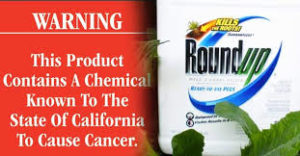 National Wheat Growers Association last month in challenging California’s listing of glyphosate as a carcinogen under the state’s Proposition 65 law. California added glyphosate to the list of cancer-causing chemicals in July 2017, but has since been attacked by Monsanto and its allies for carrying out state law that requires carcinogens to be labeled and monitored.
National Wheat Growers Association last month in challenging California’s listing of glyphosate as a carcinogen under the state’s Proposition 65 law. California added glyphosate to the list of cancer-causing chemicals in July 2017, but has since been attacked by Monsanto and its allies for carrying out state law that requires carcinogens to be labeled and monitored.
The plaintiffs, led by the National Association of Wheat Growers, argue that listing glyphosate as a carcinogen under Prop 65 will irreparably harm the agriculture industry, adversely affecting farmers and consumers throughout the U.S. The case, seeking a stay of the listing, was filed in the in Federal Court in the Eastern District of California in November, 2017. Earlier last year, Monsanto lost its case before a state Superior Court in which it sought to stay the Prop 65 listing.
Idaho, Indiana, Iowa, Kansas, Louisiana, Michigan, Missouri, North Dakota, Oklahoma, South Dakota and Wisconsin have filed an amicus brief in support of the preliminary injunction sought by agriculture groups against California’s Prop 65 regulation. The U.S. Chamber of Commerce and the California Chamber of Commerce filed their own amicus brief in support of the preliminary injunction to halt the regulation. (Nat‚Äôl Ass‚Äôn of Wheat Growers, et al. v. Zeise, et al., No. 2:17-cv-02401WBS). In their amicus brief, states point out that California‚Äôs Prop 65 mandates impede the duty of states to protect their own citizen-consumers as well as states‚Äô economic freedoms to stimulate growth, and ‚Äúencroaches on the equal sovereignty of other States‚ÄĚ
According to Lexology, the plaintiffs are arguing (1) that the First Amendment prohibits the government from compelling individuals or entities to engage in speech; and (2) that the Supremacy Clause requires state laws that conflict with federal laws to be preempted. Labeling for glyphosate is governed by certain federal regulations implemented and enforced by the U.S. Environmental Protection Agency (EPA). They have requested that the federal court declare California’s action to be improper and enjoin the state from continuing to list glyphosate as a chemical that requires a Prop 65 warning.
Further, Monsanto and the agricultural interests allege that they are already being adversely affected by the decision, but state officials maintain that there is no need to issue a preliminary injunction on the listing, rejecting the allegation that they are already being adversely impacted by the decision. Monsanto, the chemical giant that makes glyphosate (Roundup), requested the state reconsider its listing but was rejected last summer.
Under the Labor Code listing mechanism of Proposition 65, substances identified by the International Agency for Research on Cancer (IARC) must be listed in the state of California as known to cause cancer. This listing requires warning labels on products and the listed substances are subject to limits on discharges into surface waters. In March 2015, IARC found that there was sufficient evidence of carcinogenicity in experimental organisms to classify glyphosate as ‚Äúprobably carcinogenic to humans‚ÄĚ (Group 2A).
Industry has since challenged IARC‚Äôs finding, arguing that it is an outlier as an “overwhelming majority of government regulators and other experts” have found glyphosate is not carcinogenic and have “flatly rejected” IARC’s conclusion. In its request for a preliminary injunction, industry argues that they are facing “imminent harm” from the warning label requirements. The state rejects that claim, noting that the requirements will not enter into effect until July 2018 and that it has yet to determine which products will have to be labeled. The plaintiffs may speculate that a Prop 65 warning requirement will cause “an array of harm, from loss of reputation to disruption of food supply and private enforcement litigation” but their “sky-is-falling speculations” do not justify a preliminary injunction. The state agency adds that¬†Prop 65 does not “dictate the text of the warning,” providing companies the right to “tailor to its individual situation” and to “place the cancer risk in context” for the public.
Monsanto has been trying to undermine findings that show its flagship product, glyphosate, is anything other than ‚Äúsafe.‚ÄĚ However, its attempts to unduly influence and undermine scientific research and government review of its product has been disclosed widely in the press. This has prompted the European Parliament to set up a special committee to look into the¬†European Union‚Äôs (EU) authorization procedure for pesticides, in light of their recent controversial review of glyphosate. It was reported that the European Food Safety Authority (EFSA)¬†copied dozens of pages from a Monsanto¬†study in¬†reaching its conclusion that glyphosate is ‚Äúunlikely to pose a carcinogenic hazard to humans.‚Ä̬†EFSA‚Äôs recommendation was supposed to provide an independent analysis for EU member states when deciding to renew the chemical. Last year, the¬†European Parliament banned Monsanto lobbyists¬†from committee¬†meetings and digital resources, as well as prohibiting Monsanto lobbyists from meeting with any Member of the European Parliament.¬†This was an attempt to limit Monsanto‚Äôs influence on the EU review process amid mounting public pressure. Similarly, The¬†New York Times¬†reported on Monsanto‚Äôs internal emails¬†and email traffic between the company and U.S. federal regulators that suggested that Monsanto had ghostwritten research on glyphosate, which was later attributed to academics.¬†In December 2017, the U.S. Environmental Protection Agency (EPA),¬†declared that glyphosate is likely not carcinogenic, conflicting with IARC‚Äôs 2015 classification. Some charge that EPA‚Äôs assessment relied heavily on industry studies to arrive at its conclusion, and ignored its own guidelines for assessing cancer risks.
In California, the Court is set to hear arguments on the motion on February 20th.
Fight back against Monsanto’s attempt to undermine the scientific and democratic process by getting involved at the local level. Work to pass policies that restrict not only glyphosate, but the entire range of toxic synthetic pesticides registered by EPA. Beyond Pesticides has resources to help you get started, including an organizing guide, model policy, and list of less toxic, organic compatible products. For more information on IARC’s glyphosate cancer classification and the IARC review process, see Beyond Pesticides’ article in our journal Pesticides and You.
Source: The Fence Post, Legal Scoops









 (Beyond Pesticides, February 8, 2018) New trials are being launched in the United Kingdom (UK) to monitor fields that have long strips of wildflowers planted through croplands to boost natural predators and potentially reduce pesticide spraying. The large-scale trials are meant to determine how effective these strips can be as a tool for practitioners wishing to enhance biological pest control in the field.
(Beyond Pesticides, February 8, 2018) New trials are being launched in the United Kingdom (UK) to monitor fields that have long strips of wildflowers planted through croplands to boost natural predators and potentially reduce pesticide spraying. The large-scale trials are meant to determine how effective these strips can be as a tool for practitioners wishing to enhance biological pest control in the field. population of the species is continuing to decline at an alarming rate, with scientists and conservation groups pointing to man-made factors like logging, climate change, and herbicide use on genetically engineered (GE) crop fields as primary drivers. The annual California count of western monarch butterflies stationed volunteers at 262 sites, more than ever before, yet at 200,000 butterflies counted, the numbers nearly matched the lowest level recorded this decade, when only 145,000 butterflies were seen in 2012. The decline of these iconic butterflies demands swift action from lawmakers and regulators to protect their dwindling numbers.
population of the species is continuing to decline at an alarming rate, with scientists and conservation groups pointing to man-made factors like logging, climate change, and herbicide use on genetically engineered (GE) crop fields as primary drivers. The annual California count of western monarch butterflies stationed volunteers at 262 sites, more than ever before, yet at 200,000 butterflies counted, the numbers nearly matched the lowest level recorded this decade, when only 145,000 butterflies were seen in 2012. The decline of these iconic butterflies demands swift action from lawmakers and regulators to protect their dwindling numbers.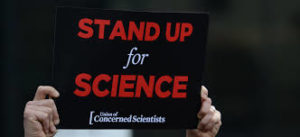 Environmental Protection Agency’s (EPA) efforts to purge academic scientists who had previously received EPA grants from sitting on the agency’s advisory committees. Last October, EPA issued a new policy that changes the makeup of its advisory boards by limiting the participation of scientists from academia and nonpartisan nonprofit organizations. Critics say the change attempts to fill these advisory committees with more industry-friendly officials whose belief systems are anti-environmental protection. On January 23, 2018, a group of scientists 
Environmental Protection Agency‚Äôs (EPA) efforts to purge academic scientists who had previously received EPA grants from sitting on the agency‚Äôs advisory committees.¬†Last October, EPA issued a new policy that changes the makeup of its advisory boards by limiting the participation of scientists from academia and nonpartisan nonprofit organizations.¬†Critics say the change attempts to fill these advisory committees with more industry-friendly officials whose belief systems are anti-environmental protection.¬†On January 23, 2018, a group of scientists¬† who grow and harvest our food. A sustainable food system must protect the land and the people who work the land, including the children and families of farmworkers. In two related actions, EPA is proposing to remove age requirements for application of pesticides. The actions involve changes to the Agricultural Worker Protection Standard (WPS), which went into effect this January and covers farmworkers hired to apply pesticides, and the Certification of Applicators (CA) rule, which will go into effect May 22 and covers those allowed to apply highly toxic restricted use pesticides (RUPs), the most toxic pesticides. The proposals to remove the age requirements present unacceptable risks to teenagers, who ‚Äúare still developing in critical physical and emotional areas, with particular regard to their brains and reproductive systems,‚ÄĚ according to the
who grow and harvest our food. A sustainable food system must protect the land and the people who work the land, including the children and families of farmworkers. In two related actions, EPA is proposing to remove age requirements for application of pesticides. The actions involve changes to the Agricultural Worker Protection Standard (WPS), which went into effect this January and covers farmworkers hired to apply pesticides, and the Certification of Applicators (CA) rule, which will go into effect May 22 and covers those allowed to apply highly toxic restricted use pesticides (RUPs), the most toxic pesticides. The proposals to remove the age requirements present unacceptable risks to teenagers, who ‚Äúare still developing in critical physical and emotional areas, with particular regard to their brains and reproductive systems,‚ÄĚ according to the  drastically underestimating chemical-intensive agriculture‚Äôs contribution to nitrogen oxide (NOx) caused air pollution, acid rain, and respiratory illness in the state, according to a
drastically underestimating chemical-intensive agriculture’s contribution to nitrogen oxide (NOx) caused air pollution, acid rain, and respiratory illness in the state, according to a 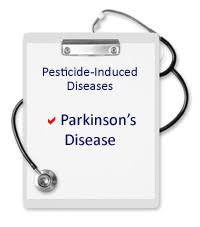 for the Biology of Aging are finding new information about how Parkinson’s disease manifests itself after exposure to the herbicide paraquat, in hopes of finding ways to prevent the progression of the disease. Despite a
for the Biology of Aging are finding new information about how Parkinson’s disease manifests itself after exposure to the herbicide paraquat, in hopes of finding ways to prevent the progression of the disease. Despite a 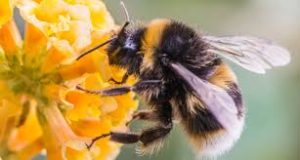 largest retailers, has decided to stop selling neonicotinoid products (neonics) linked to global declines in bee populations. This is the latest retailer in Australia to announce commitments to stop supplying the bee-toxic products.
largest retailers, has decided to stop selling neonicotinoid products (neonics) linked to global declines in bee populations. This is the latest retailer in Australia to announce commitments to stop supplying the bee-toxic products. (USGS) reveals the year-round presence of neonicotinoids (neonics) in the Great Lakes Рthe world’s largest freshwater ecosystem. Neonics, which are highly toxic to aquatic organisms and pollinators, are prevalent in the tributaries of the Great Lakes with concentrations and detections increasing during planting season. This new data adds to burgeoning demand for a federal ban of these insecticides in order to safeguard vulnerable aquatic ecosystems and pollinators.
(USGS) reveals the year-round presence of neonicotinoids (neonics) in the Great Lakes – the world‚Äôs largest freshwater ecosystem. Neonics, which are highly toxic to aquatic organisms and pollinators, are prevalent in the tributaries of the Great Lakes with concentrations and detections increasing during planting season. This new data adds to burgeoning demand for a federal ban of these insecticides in order to safeguard vulnerable aquatic ecosystems and pollinators. of the public and the environment at the U.S. Environmental Protection Agency (EPA) are being encouraged to exit the agency ‚Äďas EPA Administrator Scott Pruitt plans to meet his goal of cutting agency staff and programs by 50 percent.
of the public and the environment at the U.S. Environmental Protection Agency (EPA) are being encouraged to exit the agency ‚Äďas EPA Administrator Scott Pruitt plans to meet his goal of cutting agency staff and programs by 50 percent. (Beyond Pesticides, January 26, 2018) Triclosan may be on its way out in soaps and disinfectants, but its presence on toothbrushes could stick around for a long time, according to
(Beyond Pesticides, January 26, 2018) Triclosan may be on its way out in soaps and disinfectants, but its presence on toothbrushes could stick around for a long time, according to  from April 16 to October 31, 2018 in Arkansas, following a vote this week by the state’s Legislative Council. Action by lawmakers was the last step needed to make the ban official after the Arkansas State Plant Board (ASPB) voted last year to continue a
from April 16 to October 31, 2018 in Arkansas, following a vote this week by the state’s Legislative Council. Action by lawmakers was the last step needed to make the ban official after the Arkansas State Plant Board (ASPB) voted last year to continue a  survival of honey bees and their colonies, according to research published by scientists from University of California, San Diego (UCSD). This is the first study to delve into the real-world effects pesticide exposure can have on honey bees also subject to nutritional stress, a common occurrence in the wild. The outcome of this research highlights the weaknesses of the U.S. Environmental Protection Agency’s (EPA) testing regime for registering pesticides, which does not account for the complex ecology surrounding
survival of honey bees and their colonies, according to research published by scientists from University of California, San Diego (UCSD). This is the first study to delve into the real-world effects pesticide exposure can have on honey bees also subject to nutritional stress, a common occurrence in the wild. The outcome of this research highlights the weaknesses of the U.S. Environmental Protection Agency’s (EPA) testing regime for registering pesticides, which does not account for the complex ecology surrounding  European Union’s (EU) authorization procedure for pesticides, in light of the controversial review of Monsanto’s glyphosate. The special committee is to assess the authorization procedure for pesticides in the EU and potential failures in how substances are scientifically evaluated and approved.
European Union’s (EU) authorization procedure for pesticides, in light of the controversial review of Monsanto’s glyphosate. The special committee is to assess the authorization procedure for pesticides in the EU and potential failures in how substances are scientifically evaluated and approved. jeopardize the continued existence of endangered species and adversely modify their critical habitats, according to the newly released report from the National Marine Fisheries Service (NMFS). By law, the Environmental Protection Agency (EPA) must not allow their use.
jeopardize the continued existence of endangered species and adversely modify their critical habitats, according to the newly released report from the National Marine Fisheries Service (NMFS). By law, the Environmental Protection Agency (EPA) must not allow their use.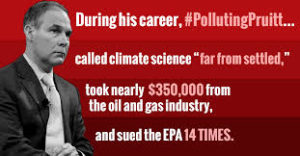 charged with protecting the health of the public and the environment at the U.S. Environmental Protection Agency (EPA) are being encouraged to exit the agency. This, as EPA Administrator Scott Pruitt plans to meet his goal of cutting agency staff and programs by 50 percent.
charged with protecting the health of the public and the environment at the U.S. Environmental Protection Agency (EPA) are being encouraged to exit the agency. This, as EPA Administrator Scott Pruitt plans to meet his goal of cutting agency staff and programs by 50 percent.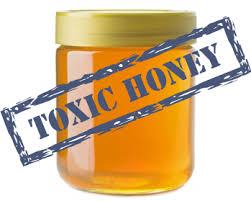 has shown that ‚ÄĒ despite a partial ban on neonicotinoid insecticides instituted in 2014 ‚ÄĒ 25% of British honey is still contaminated with residue of these ‚Äúpotent, bee-killing‚ÄĚ pesticides. The partial ban, which extended to flowering crops, such as oilseed rape (from which canola oil is made), was instituted by the European Union (EU) in response to evidence of serious threats to bee populations. Samples for this study came from beekeepers and were each from a single location.
has shown that ‚ÄĒ despite a partial ban on neonicotinoid insecticides instituted in 2014 ‚ÄĒ 25% of British honey is still contaminated with residue of these ‚Äúpotent, bee-killing‚ÄĚ pesticides. The partial ban, which extended to flowering crops, such as oilseed rape (from which canola oil is made), was instituted by the European Union (EU) in response to evidence of serious threats to bee populations. Samples for this study came from beekeepers and were each from a single location. chlorpyrifos
chlorpyrifos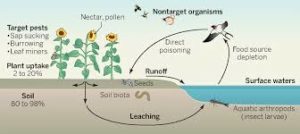 insecticides pose both acute and chronic risks to pollinators, aquatic life, and birds, the U.S. Environmental Protection Agency (EPA) is seeking comment that could support their continued use. Comments are due by February 20, 2018. 
insecticides pose both acute and chronic risks to pollinators, aquatic life, and birds, the U.S. Environmental Protection Agency (EPA) is seeking comment that could support their continued use. Comments are due by February 20, 2018.  herbicide glyphosate and the fungicide chlorothalonil at certain concentrations,
herbicide glyphosate and the fungicide chlorothalonil at certain concentrations, 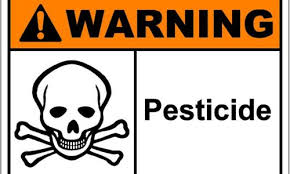 pesticide spraying at schools, organic farms, and backyards across California because of inadequate public disclosure of the chemicals‚Äô adverse effects.¬†The California Department of Food and Agriculture‚Äôs (CDFA) statewide ‚Äúpest management‚ÄĚ program required no site-specific analysis of risks before the application of 79 pesticides, including some known to cause cancer and birth defects and to be highly toxic to bees, butterflies, fish and birds.
pesticide spraying at schools, organic farms, and backyards across California because of inadequate public disclosure of the chemicals‚Äô adverse effects.¬†The California Department of Food and Agriculture‚Äôs (CDFA) statewide ‚Äúpest management‚ÄĚ program required no site-specific analysis of risks before the application of 79 pesticides, including some known to cause cancer and birth defects and to be highly toxic to bees, butterflies, fish and birds. unanimously to adopt a policy prioritizing the use of organic and defined “least-toxic” pesticides to manage pest problems on city-owned and controlled property and public rights-of-way. Buoyed by a strong and growing coalition of¬†
unanimously to adopt a policy prioritizing the use of organic and defined “least-toxic” pesticides to manage pest problems on city-owned and controlled property and public rights-of-way. Buoyed by a strong and growing coalition of¬† 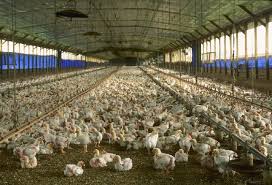 by the Trump Administration to scuttle the final rule on organic animal welfare (the Organic Livestock Poultry Practices rule, or OLPP) that was adopted as a final rule a year ago.
by the Trump Administration to scuttle the final rule on organic animal welfare (the Organic Livestock Poultry Practices rule, or OLPP) that was adopted as a final rule a year ago.
